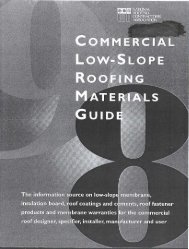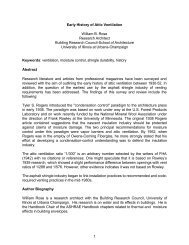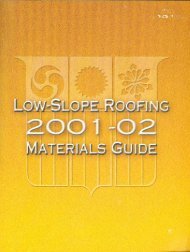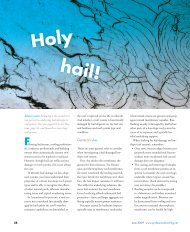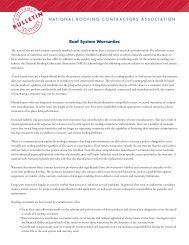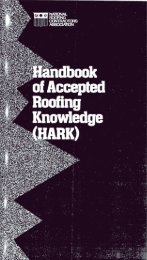New Test Method To Assess The Walkability Of Roof Insulation Boards
New Test Method To Assess The Walkability Of Roof Insulation Boards
New Test Method To Assess The Walkability Of Roof Insulation Boards
You also want an ePaper? Increase the reach of your titles
YUMPU automatically turns print PDFs into web optimized ePapers that Google loves.
<strong>New</strong> <strong>Test</strong> <strong>Method</strong> <strong>To</strong> <strong>Assess</strong> <strong>The</strong> <strong>Walkability</strong> <strong>Of</strong> <strong>Roof</strong> <strong>Insulation</strong> <strong>Boards</strong><br />
Nico A. Hendriks<br />
KEY WORDS: <strong>Insulation</strong> boards, roofing, walkability, test method and dynamic loading<br />
ABSTRACT<br />
For many years problems and failures with roof systems on insulation have occurred,<br />
caused by more or less frequent pedestrian traffic, mostly during the installation period.<br />
<strong>The</strong>se problems relate specifically to mineral wool though frequent loading also can<br />
damage other insulation boards. <strong>The</strong> new European Standard, EN 12430:1998<br />
“Determination of behaviour under point load”, is totally inadequate though the objective<br />
is to determine whether a product has sufficient strength to withstand forces caused by<br />
pedestrian traffic. <strong>The</strong> result of a test according to this standard is more or less the<br />
compression strength of the tested insulation board. In actual practice, repeated loading<br />
can damage certain materials with good compression strength. <strong>The</strong>refore, a new test<br />
method has been developed using an apparatus called ‘<strong>The</strong> BDA Marathon Man’ to<br />
simulate the repeated dynamic loading caused by a walking person. This paper<br />
describes the research program that has been carried out. <strong>The</strong> result is a new draft test<br />
method that provides for the classification of insulation boards with respect to<br />
walkability. Also, a comparison is given with observations on relevant roof failures in<br />
actual practice.<br />
AUTHOR BIOGRAPHY<br />
Nico A. Hendriks is professor in Building Materials and Sustainable Construction at the<br />
Technische Universiteit Eindhoven. He is also president of the BDA <strong>Test</strong> Institute,<br />
Gorinchem, <strong>The</strong> Netherlands.<br />
INTRODUCTION<br />
Problems and failures with roof systems on insulation occur caused by more or less<br />
frequent pedestrian traffic. <strong>The</strong>se problems relate specifically to mineral wool though<br />
frequent loading also can damage other insulation boards. In actual practice, repeated<br />
loading can damage certain materials with good compression strength. <strong>The</strong> new<br />
European Standard, EN 12430:1998 “Determination of behaviour under point load”, is<br />
totally inadequate though the objective is to determine whether a product has sufficient<br />
strength to withstand forces caused by pedestrian traffic. <strong>The</strong> result of a test according<br />
this standard is more or less the compression strength of the tested insulation board. By<br />
order of BING, the European Organization of Polyurethane Foam Manufacturers, an<br />
extensive research program has been carried out to establish a test method that<br />
simulates the dynamic loading by pedestrian traffic.<br />
1
ROOF DAMAGE BY PEDESTRIAN TRAFFIC<br />
During the installation period frequent pedestrian traffic on a low-slope roof can occur<br />
specifically with new construction projects and involving other building activities. This<br />
dynamic form of loading can cause severe damage to the insulation material and,<br />
subsequently, to the roofing material. <strong>The</strong> damage may happen despite specified<br />
measures to protect insulation boards and roofing materials during the construction<br />
phase. An example of such damage is shown in Photo 1.<br />
Photo 1. Damage to roofing material caused by destruction of insulation material by<br />
frequent pedestrian traffic<br />
OBJECTIVE OF THE RESEARCH<br />
<strong>The</strong> objective of the research program was to draft a reproducible test to predict<br />
whether a roof insulation product is suitable to withstand repetitive walking on a roof<br />
especially during application but furthermore during maintenance. Linked to this test<br />
method, a classification system had to be set up to be able to rank roof insulation<br />
products with regard to the use of a roof.<br />
Starting points<br />
For the development of the test it has been based on the principle that the insulation<br />
shall withstand the pressure of the foot of a person weighing 70 kg and carrying a load<br />
of 30 kg, for instance a roll of roofing membrane. This load corresponds with a vertical<br />
load of 980 N on a die with an 80-mm diameter.<br />
2
<strong>The</strong> test apparatus was designed to simulate repetitive walking by applying a dynamic<br />
and repeated force onto the insulation through a battery connecting 16 cylinders<br />
conducting 16 dies placed above the product to be tested. During one subcycle, each<br />
die is loading the test specimen subsequently. <strong>To</strong> load the product in the most equally<br />
distributed manner, after each subcycle, the test specimen is moved over half the center<br />
to center distance of the dies. <strong>The</strong>se movements are executed from front to back and<br />
from left to right (or reverse).<br />
<strong>To</strong> translate the real forces transmitted to a roof by a pedestrian, a radial force is<br />
applied onto the insulation to simulate the friction that occurs between a shoe sole and<br />
substrate. According to information supplied by a research center for the shoe<br />
manufacturing industry, this radial load is about one-third of the axial load. <strong>The</strong>refore,<br />
this load is set at 390 N.<br />
<strong>To</strong> apply a realistic load on the insulation, the underside of each die has been rounded<br />
and provided with a profile. <strong>To</strong> prevent the die from slipping when the radial force is<br />
applied, the underside of the die is made of a material comparable with the sole of a<br />
workman’s shoe. According to the information of a research center for the shoe<br />
manufacturing industry, the most suitable material for the underside is polyurethane with<br />
a 60 Shore A hardness.<br />
Photo 2 shows the test apparatus. Shortly after the construction of the first prototype it<br />
was called the BDA Marathon Man.<br />
Photo 2. <strong>Test</strong> apparatus: the BDA Marathon Man<br />
3
<strong>The</strong> schematic principle of the test apparatus is given in Photo 3.<br />
Photo 3. Schematic principle<br />
TEST PROGRAM<br />
Samples<br />
<strong>The</strong> samples to be tested were all purchased at one company that was chosen at<br />
random. <strong>The</strong> following insulation products have been used:<br />
- PUR (rigid polyurethane foam)<br />
- MWR (pressed mineral wool)<br />
- EPS (expanded polystyrene)<br />
- XPS (extruded polystyrene foam)<br />
For the correlation between the different products, it was decided all the samples should<br />
have approximately the same thermal resistance (R = approx. 3.2 m 2⋅ K⋅W -1 ). This<br />
resulted in the samples as given in Table 1.<br />
4
Table 1. <strong>Test</strong>ed samples<br />
Product<br />
Thickness<br />
Density<br />
Facing<br />
[mm]<br />
[kg⋅m -3 ]<br />
PUR 90 30 Two sided with bituminized glass mat<br />
MWR 130 160 None<br />
EPS 120 20 One sided with bituminized glass mat<br />
XPS 120 25 None<br />
<strong>Test</strong> procedure<br />
<strong>The</strong> test procedure covers the testing of insulation products without any waterproofing<br />
and without any other cycling (with an ageing effect) than the repetitive loading<br />
(mechanical cycling) applied on the test specimens by the BDA Marathon Man. This<br />
was decided to prevent having too many parameters at this stage of development.<br />
<strong>The</strong> mechanical cycling was applied on the test specimens subsequently for 10, 30 and<br />
100 cycles. <strong>The</strong> number of cycles has been determined from the frequency of<br />
pedestrian traffic on different categories of roofs. Following the draft description of the<br />
test method, the thickness and the compressive strength were determined before and<br />
after testing.<br />
Four consultants and inspectors of BDA, independently of each other, judged the test<br />
specimens. <strong>The</strong>se experts were asked to give their opinions about the appearance of<br />
the test specimen after various test cycles and relate them to known actual damage.<br />
Results<br />
<strong>The</strong> results of the tests and the judgments are given in Tables 2, 3 and 4.<br />
Table 2. Thickness [mm]<br />
Product<br />
Initial<br />
thickness<br />
After 10<br />
cycles<br />
After 30 cycles<br />
After 100 cycles<br />
PUR 90 88 88 85<br />
MWR 129 127 not measured 1) not measured 1)<br />
EPS 120 117 115 110<br />
XPS 120 120 not measured 2) 120<br />
5
Table 3. Compressive strength [kPa]<br />
Product<br />
Initial compressive<br />
strength<br />
After 10<br />
Cycles<br />
After 30 cycles<br />
After 100<br />
cycles<br />
PUR 119 120 104 104<br />
MWR 74 6 not measured 1) not measured 1)<br />
EPS 90 94 83 78<br />
XPS > 800 3) at 3% > 800 3) at 2% not measured 2) > 800 3) at 3%<br />
1) Not measured because the test specimens had been destroyed; this is caused for<br />
reason because vertically applied forces develop transverse forces inside the test<br />
specimen.<br />
2) Not measured because based on the result after 100 cycles, no changes were to<br />
be expected.<br />
3) Strength at maximum reach of the test equipment; the deformation at that moment<br />
is given.<br />
Table 4. Judgement on appearance<br />
Product After 10 cycles After 30 cycles After 100 cycles<br />
PUR realistic realistic 3) not realistic 4)<br />
MWR realistic 1) not realistic not realistic<br />
EPS realistic realistic 3) not realistic 4)<br />
XPS realistic not measured 2) realistic<br />
6
1) Some experts stated that in actual practice damage could even be worse.<br />
2) Not measured because based on the result after 100 cycles, no changes were to<br />
be expected.<br />
3) At locations where much pedestrian traffic occurs, such as the entrance to a roof.<br />
4) Only occasionally at locations where, for instance, tools have been dropped on a<br />
roof.<br />
Photos 4 and 5 show examples of some test specimen after testing.<br />
Photo 4. Mineral wool test specimen after 10 cycles<br />
Photo 5. Polyurethane board test specimen after 30 cycles<br />
7
EVALUATION AND DRAFT CLASSIFICATION<br />
Based on the results found at the development of this test method and the experience<br />
of the experts of BDA, the following criteria for the properties of the insulation boards<br />
after testing have been drafted.<br />
Thickness: - Maximum allowable decrease of thickness: 10 percent, but not more than<br />
10 mm<br />
Compressive strength: - maximum allowable decrease: 25 percent<br />
Classification<br />
<strong>To</strong> classify roof insulation boards with respect to their intended use, a classification<br />
system has been drafted as given in Table 5.<br />
Table 5. Draft classification system<br />
Class<br />
Number<br />
of cycles<br />
Intended use of the roof<br />
1 10 Only accessible for purpose of maintenance; may be used<br />
without any restrictions<br />
2 30 Accessible to pedestrian traffic; may be used where frequent<br />
maintenance of equipment is envisaged<br />
3 100 Accessible to lightweight vehicles; only to be used where the<br />
waterproofing is protected by concrete pavers or similar<br />
protection<br />
FURTHER RESEARCH<br />
Laboratory tests, though always meant to predict the behaviour of products in practice,<br />
can never exactly simulate practice. <strong>To</strong> make results clear, it is recommended to<br />
exaggerate practice to obtain a wider scale and be able to interpret the results easier.<br />
However, a test must never be so severe that the results lead to the other extreme,<br />
such as in the case of 30 cycles and more, the total damaging of the MWR insulation<br />
product. Also, in that case, no interpretation is possible.<br />
<strong>The</strong> appearance of the MWR insulation after 30 cycles and 100 cycles was judged to be<br />
not realistic. This appearance is caused, among other reasons, because the vertically<br />
applied forces develop transverse forces inside the test specimen. This results in the<br />
falling apart of the specimen first at the edges and, subsequently, over the entire<br />
specimen.<br />
8
In further research, a supporting framework around test specimens will be applied. This<br />
can be compared with the actual situation in the roof where the insulation boards are<br />
also sideways supported. This will, no doubt, give more realistic results for mineral wool.<br />
Furthermore, the absence of a waterproofing membrane during the test is only<br />
representative for the first part of the roof installation. In case this classification is only<br />
meant for products not covered during application, this way of testing is correct. In case<br />
this test method shall also be used to predict the behaviour during lifetime, it is<br />
necessary to investigate the effect of the addition of a reproducible membrane<br />
simulating roofing felt. This could be, for instance, a nonreinforced EPDM roof<br />
membrane fixed at the edges. This will be investigated in further research.<br />
CONCLUSIONS<br />
1. <strong>The</strong> drafted new test method to assess the walkability of roof insulation gives<br />
realistic results for certain combinations of insulation materials and cyclic loading.<br />
2. However, specifically for mineral wool, it is necessary to apply a supporting<br />
framework to prevent transverse forces and get a more realistic loading. This is to be<br />
investigated in further research.<br />
3. It seems to be possible with the (adapted) test method to classify roof insulation<br />
boards with respect to the intended use of a roof.<br />
4. It is also needed to further investigate the effect of the addition of a reproducible<br />
membrane simulating roofing felt.<br />
ACKNOWLEDGEMENT<br />
<strong>The</strong> author wishes to acknowledge the co-operation of the Dutch Association of<br />
Polyurethane Manufacturers (NVPU) and Koert van Zee, Albert Hameete and Pieter<br />
Dorresteijn of the BDA <strong>Test</strong> Institute.<br />
REFERENCES<br />
[1] EN 12430: 1998 “<strong>The</strong>rmal insulating products for building applications -<br />
Determination of behaviour under point load”, CEN, 1998-06<br />
[2] “<strong>The</strong>rmal insulating products for roofs - Determination of the resistance to repetitive<br />
loading”, draft test method, BDA Keuringsinstituut B.V., 2001-08<br />
9




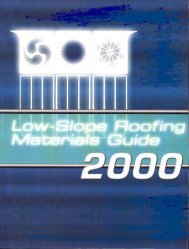
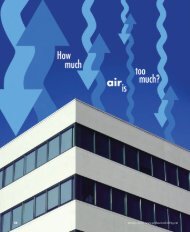
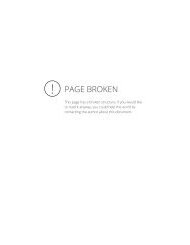
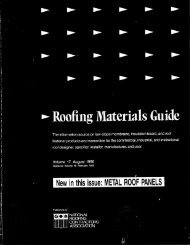
![Wm] - National Roofing Contractors Association](https://img.yumpu.com/36696816/1/190x245/wm-national-roofing-contractors-association.jpg?quality=85)

